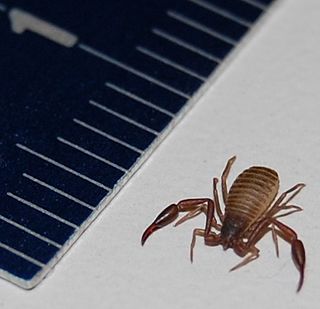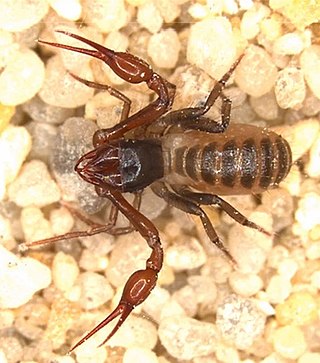Cryptocheiridium is a genus of pseudoscorpions in the Cheiridiidae family. It was described in 1931 by American arachnologist Joseph Conrad Chamberlin.
Nesidiochernes is a genus of pseudoscorpions in the Chernetidae family. It was described in 1957 by Austrian arachnologist Max Beier.

Cheliferidae is a family of pseudoscorpions in the order Pseudoscorpiones, first described by Antoine Risso in 1827.
Austrochernes is a genus of pseudoscorpions in the subfamily Chernetinae, first described by Max Beier in 1932. Species of this genus are found in mainland Australia and New Guinea. The Australian Faunal Directory decisions for synonymy are based on a 2018 paper by Mark Harvey.
Austrochthonius is a genus of pseudoscorpions in the family Chthoniidae. It was described in 1929 by American arachnologist Joseph Conrad Chamberlin.

Pseudotyrannochthonius is a genus of pseudoscorpions in the family Pseudotyrannochthoniidae. It was described in 1930 by Austrian arachnologist Max Beier.
Paraustrochernes is a genus of pseudoscorpions in the Chernetidae family. It is native to Australasia, and was described in 1966 by Austrian arachnologist Max Beier.
Calymmachernes is a monotypic genus of pseudoscorpions in the Chernetidae family. It is endemic to Australia. It was described in 1954 by Austrian arachnologist Max Beier.

Conicochernes is a genus of pseudoscorpions in the Chernetidae family. It is endemic to Australia. It was described in 1948 by Austrian arachnologist Max Beier.
Megachernes is a genus of pseudoscorpions in the Chernetidae family. It was described in 1932 by Austrian arachnologist Max Beier.
Australochelifer is a monotypic genus of pseudoscorpions in the Cheliferidae family. It was described in 1975 by Austrian arachnologist Max Beier.
Nannochelifer paralius is a species of pseudoscorpion in the Cheliferidae family. It is endemic to Australia. It was described in 1984 by Australian arachnologist Mark Harvey. The specific epithet paralius comes from the Greek paralios, referring to the species’ habitat.
Protochelifer is a genus of pseudoscorpions in the Cheliferidae family. It was described in 1948 by Austrian zoologist Max Beier.
Afrosternophorus is a genus of pseudoscorpions in the Sternophoridae family. It was described in 1967 by Austrian arachnologist Max Beier.
Protogarypinus is a genus of pseudoscorpions in the Garypinidae family. It is endemic to Australia. It was described in 1954 by Austrian arachnologist Max Beier.
Solinus is a genus of pseudoscorpions in the Garypinidae family. It was described in 1930 by American arachnologist Joseph Conrad Chamberlin.
Austrohorus is a monotypic genus of pseudoscorpions in the Olpiidae family. It is endemic to Australia. It was described in 1966 by Austrian arachnologist Max Beier.
Beierolpium is a genus of pseudoscorpions in the Olpiidae family. It was described in 1976 by French arachnologist Jacqueline Heurtault.

Olpium is a genus of pseudoscorpions in the Olpiidae family. It was described in 1873 by German arachnologist Ludwig Carl Christian Koch.
Paraliochthonius is a genus of pseudoscorpions in the Chthoniidae family. It was described in 1956 by Austrian arachnologist Max Beier.



